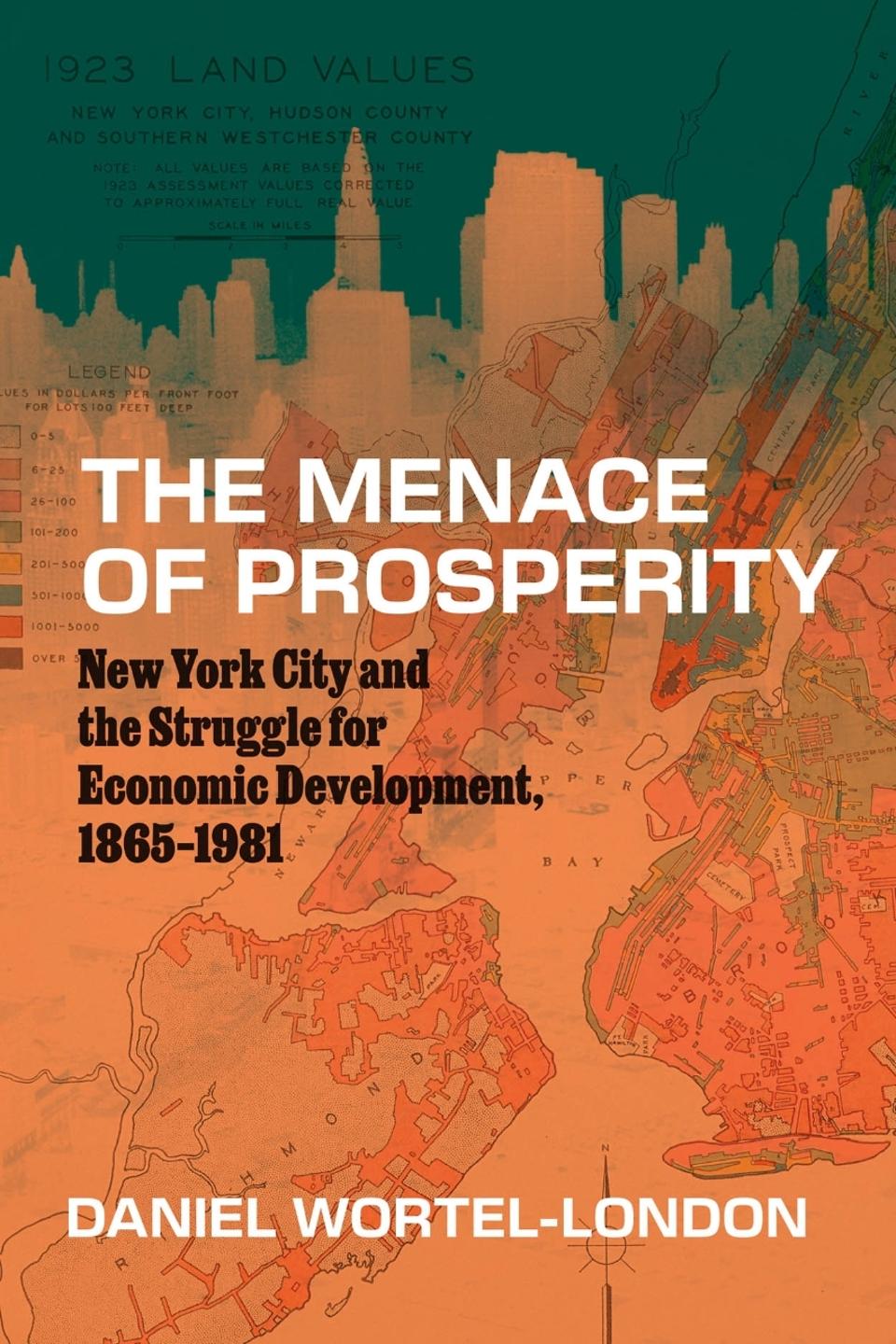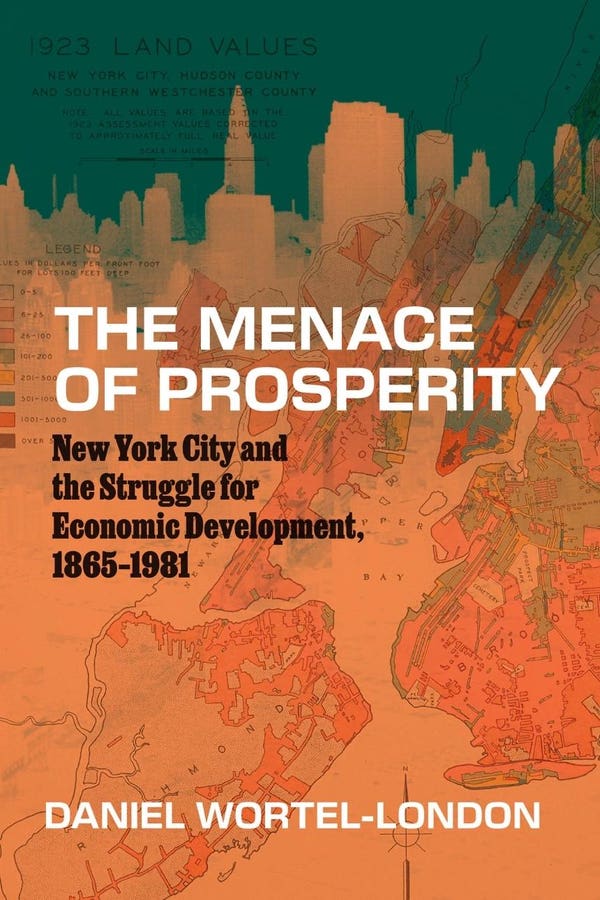
“The Menace of Prosperity” gives an important history of New York’s fights over economic growth and inequality.
The University of Chicago Press, 2025
The likely election of democratic socialist Zorhan Mamdani as the next mayor of New York City is sparking intensive debate about the city’s economy, the role of government, and the future of democracy. Mamdani’s blunt statement that “I don’t think we should have billionaires” challenges New Yorkers to reconsider who benefits from the city’s prosperity– and what alternatives might be possible.
That makes Daniel Wortel-London’s The Menace of Prosperity: New York City and the Struggle for Economic Development, 1865-1981 (University of Chicago) especially welcome. Both richly detailed and visionary, The Menace of Prosperity is an ambitious and important new history of New York’s recurring struggles over growth and inequality.
New York City’s Forgotten Economic Alternatives
Wortel-London argues that New York, like other cities, has repeatedly embraced an overly narrow conception of the economy. He documents in detail the history of ideas and conflicts shaping the city’s tax, budget, and investment policies. At the center of this history is what he calls New York’s “fiscal imaginary”: an enduring obsession with pushing up real estate values through favorable taxation, zoning, and infrastructure investments that foster debt-driven speculation.
Both private investors and the city take on more and more debt to finance this strategy, producing repeated fiscal crises when the debt can’t be paid off due to economic and financial stagnation or reversals. He calls these “hidden flows of profits and plunder” that “deepened inequalities while wrecking urban economies.”
Yet he refuses to see this history as inevitable. He highlights reformers, visionaries, and civic movements advocating “alternative development strategies” that rely on cooperation, public investment that was not captured by private interests, and small and community businesses rather than speculation and rent-seeking.
Wortel-London traces New York’s evolution from post-Civil War industrial center to the finance-dominated city that emerged from the 1970s fiscal crisis, tied to the city’s long-term focus on rising real estate values and speculation. His central argument is that this trajectory—culminating in finance’s dominance and deep inequality— was neither inevitable nor the best way to achieve broadly shared prosperity.
He shows that New York has always hosted competing visions of what a good economy should be and who it should serve. But he sees that vision as eroding over time, and one of his goals is reigniting debate over how the city’s economy could be better organized to foster greater cooperation and equality.
Challenging Standard Views Of New York City’s Economy
At the heart of Wortel-London’s analysis is his concept of “fiscal imagination”—what he defines as “the set of ideas people use to define what the economy is, how it works, and what it’s for.” From the 1860s through the 1980s, New Yorkers repeatedly disputed how to balance economic growth, well-being, and justice. What prevailed, in his view, was a narrow vision built on driving up private real estate values, supported by favorable taxation, zoning and regulation, and infrastructure investments, financed by ever-rising levels of public and private debt.
This stands in contrast to the more standard narrative of New York’s rise as a port, developing logistics and finance tied to trade; its rise and decline as a manufacturing center; and its transformation into today’s finance-driven, unequal city. Businesses seeking profits and scale drove the economy, constrained at times by reformers seeking to share prosperity through progressive taxation and spending on public goods like housing, transportation, education, and public health.
Wortel-London gives us a far more contested history where reformers, visionaries, social critics, and working people sought to reimagine the economy, just regulate and tax large companies and tax the wealthy.
Postwar liberalism, in his view, relied too heavily on what economist John Kenneth Galbraith called “countervailing power, ” encouraging private investment along with adequate returns to labor and tax-supported provision of public goods. Modern mayors, from John Lindsay to Michael Bloomberg, saw economic growth and social spending as “not contradictory but complementary: the revenue furnished by taxing the welfare would help finance both social programs and the city’s general budget.”
Analyzing the aftermath of New York’s 1970s fiscal crisis, he says “most liberal policy makers focused on expanding the city’s welfare state rather than questioning the economic development strategies which helped finance it,” with the limited policy debate “marking the bankruptcy of economic thought and policy in New York.”
Real People And Real Arguments About New York City’s Economy
One of the book’s great strengths is its emphasis on human agency—the people who fought, argued, and imagined different futures for New York’s economy. Rather than treating history as the impersonal abstractions of economists like “households” and “businesses”, or some leftists’ mechanical invocation of “capitalism,” Wortel-London shows us real people having real fights and arguments over the economy.
He describes both the long sweep and logic of New York’s economic and political history and also the specific people who tried to reshape it, even when their visions failed. Some are well-known, like economist Henry George, the author of Progress and Poverty, who advocated a single tax on land and municipal ownership of utilities and transportation, or urbanist Jane Jacobs who emphasized neighborhood vitality as fostering the innovation that powers city economies.
Others are less known but equally vivid– forgotten reformers, civic activists, and ordinary residents who pressed for alternative economic visions. But he criticizes even sympathetic reformers for accepting the speculative real estate paradigm. Both pro-business and pro-social welfare coalitions came to see growth and social spending as complementary, with disagreements on types and levels of taxation, and how to spend the proceeds.
What I Learned And Where I Disagree
The Menace of Prosperity is a first-rate book that deepened my understanding of the centrality of real estate speculation and policies to New York’s economic past and future. I learned more about the contestation of these ideas, and how reformers across the city’s history struggled to imagine alternatives yet remained trapped by a crisis-prone fiscal logic that depended on rising real estate values and municipal debt.
The book also reframes the 1970s fiscal crisis not just as bad financial management, but as the culmination of a century-long faith in debt-financed urban growth. This is newly relevant as New York and other cities now feel ever-greater fiscal pressures from reduced federal and state aid alongside rising demands for education, social services, and affordable housing.
But I’m skeptical of some aspects of Wortel-London’s analysis. In my view, he sometimes truncates his analyses to support his argument. For example, Henry George was a strong advocate of a single land tax, but he wasn’t a radical–he also was a vigorous champion of free trade and distrusted extensive government regulation of business.
Economist Richard Ely, described as favoring “radical fiscal reform,” supported borrowing for infrastructure and other public purposes to fuel economic growth, paid for by progressive taxation, the model that Wortel-London criticizes throughout the book. Although the book’s critique of debt and recurrent fiscal crises hits home, it isn’t clear what the alternative is—overly limited borrowing could constrain investment and growth.
Wortel-London cites urbanist Lewis Mumford favorably, especially his questioning of expansive economic growth. But Mumford disliked big cities—in his essay “The Intolerable City” he said “the mouths of our great cities are gigantic hoppers that devour the human spirit.” And Wortel-London’s ironic stance towards reformers is marked by his repeated use of quotes around terms like “scientific”, as when he says “the ‘scientific’ ethos of the emergent professional class.”
At times, he flirts with “degrowth” ideas, invoking worker cooperatives and community-based development as an alternative path for New York’s economy. While intriguing, these alternatives feel romanticized, and cannot achieve the scale necessary for broad economic prosperity.
But these reservations do not diminish the book’s value. Wortel-London compels readers to re-think their assumptions about urban economies and New York. The Menace of Prosperity is a major and timely contribution to understanding New York’s history and to debates about its future. It reminds us economies are built by real people, through real ideas, alternatives, and choices, and that imagining different paths is an essential step towards change and progress. Mamdani and his advisors would do well to read it.
